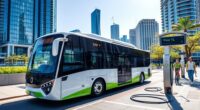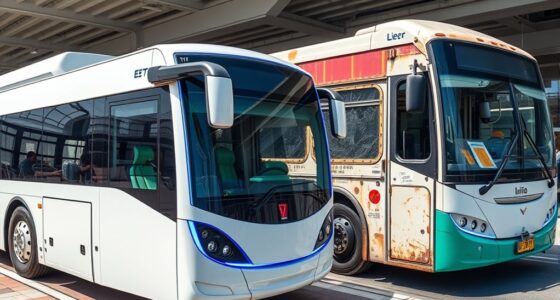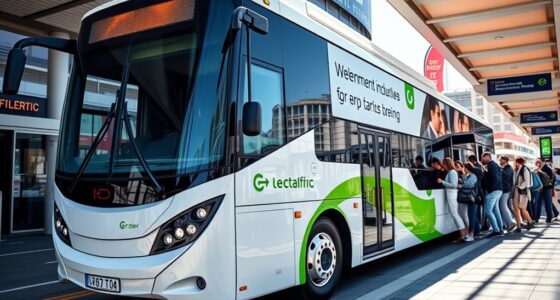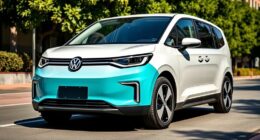To calculate ROI on electric bus investments, you need to compare your initial costs—bus price, charging infrastructure, and training—with the operational savings from lower fuel, maintenance, and repairs over its lifespan. Factor in residual or resale values and apply discounted cash flow analysis to see the present value of your savings. Considering financing options and potential grants can boost returns. Keep exploring; you’ll find detailed methods to optimize your investment’s profitability.
Key Takeaways
- Estimate total upfront costs including bus purchase, charging infrastructure, and installation expenses, then subtract applicable grants or subsidies.
- Calculate annual operating savings from reduced fuel and maintenance costs, considering energy prices and warranty coverage.
- Determine residual or salvage values for buses and chargers, factoring in depreciation and second-life battery applications.
- Perform discounted cash flow (DCF) analysis over the bus lifecycle, incorporating savings, expenses, and salvage values to find NPV.
- Assess the payback period and internal rate of return (IRR) to evaluate investment viability against your organization’s hurdle rate.
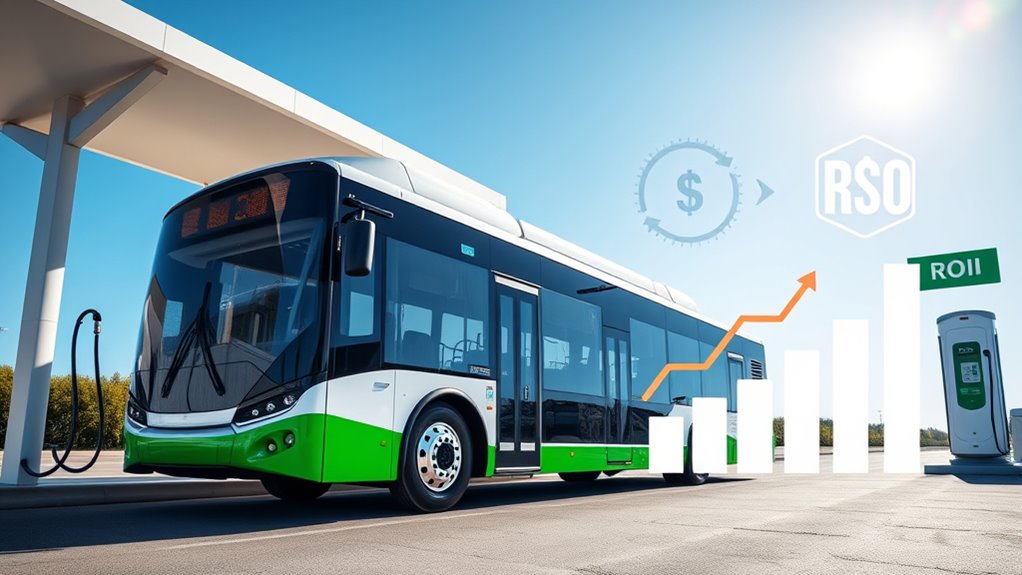
Calculating the ROI on electric bus investments enables you to assess their financial viability and long-term benefits accurately. To start, you need to determine the upfront costs, which are typically higher than diesel buses. These include the purchase price of the electric buses, the charging infrastructure—such as depot chargers, on-route chargers, and any necessary grid upgrades—and any grants or subsidies you can secure. For example, a $1.5 million grant in your baseline scenario can substantially reduce your initial investment deficit.
Don’t forget to account for battery replacement costs if they aren’t covered by warranties, as well as expenses related to training staff and establishing safety protocols for working with new technology. Considering the nutritional value of various energy sources used in charging can also influence operational costs and sustainability goals.
Next, focus on projected operating cost savings. Electric buses offer substantial reductions in fuel and maintenance costs. Electricity is generally cheaper per mile than diesel, measured in kW-hr/mile. Maintenance costs decrease because electric motors have fewer moving parts, lowering annual servicing expenses. Many warranties cover first-year maintenance, further reducing initial operational costs.
Regenerative braking systems help improve energy efficiency by recapturing energy during deceleration, and less downtime due to fewer repairs means buses spend more time on the road, generating revenue.
Incorporate salvage values into your calculations. Electric buses tend to retain higher resale value than diesel counterparts, thanks to higher upfront costs and increasing demand for used EVs. Charger residual values depend on their lifespan relative to your project duration, while batteries can be recycled or repurposed for second-life applications, offsetting disposal costs.
Use appropriate depreciation schedules—accelerated or linear—to reflect tax benefits, and consider the emerging resale markets for used electric buses, which can influence your projected returns.
Applying discounted cash flow (DCF) analysis is essential for an accurate ROI estimate. Calculate the net present value (NPV) of your projected cash flows over a typical 12-year bus lifecycle, using a discount rate that aligns with your organization’s risk tolerance, often between 5-10%.
Map out annual savings and expenses, considering the timing of cash flows. The payback period, whether discounted (around 3.6 years) or nondiscounted (about 3.4 years), helps you understand how quickly your investment will recover.
Make sure your internal rate of return (IRR) exceeds your hurdle rate to justify the project.
Finally, model the total cost of ownership (TCO) by considering factors like battery degradation, route-specific energy use, charging strategies, and labor costs for drivers and technicians. Sensitivity testing helps you evaluate how energy price fluctuations, grant availability, advancements in battery tech, regulatory changes, and fleet utilization impact your ROI.
Comparing charging options—depot, on-route, or battery swapping—allows you to optimize infrastructure costs and operational efficiency.
Frequently Asked Questions
What Are the Hidden Costs of Electric Bus Maintenance?
You should consider the hidden costs of electric bus maintenance, such as battery durability and potential component replacements, which can be more expensive than traditional vehicles.
While electric propulsion systems require less routine upkeep, they need specialized expertise for repairs.
Additionally, future recycling and disposal of batteries add to long-term costs.
Keep in mind that these hidden expenses can impact your overall maintenance budget and long-term operational costs.
How Do Government Incentives Impact ROI Calculations?
Government incentives play a pivotal role in your ROI calculations by lowering your initial investment costs. They include grants, tax credits, and subsidies that reduce upfront expenses for electric buses and charging infrastructure.
These incentives not only make purchasing more affordable but also improve long-term savings through lower operational costs. By factoring in these benefits, you’ll get a clearer picture of the true return on your electric bus investments.
What Lifespan Assumptions Should Be Used for Electric Buses?
You should assume an electric bus lifespan of about 10 to 12 years, but consider factors like battery health and operating conditions.
Batteries typically last 5 to 7 years, so plan for potential replacement costs within that period.
Environmental factors, usage patterns, and maintenance can also influence longevity, so it’s wise to build some flexibility into your assumptions for a more accurate projection.
How Does Route Complexity Affect Electric Bus Efficiency?
Ever wonder how route complexity can secretly influence your electric bus’s efficiency? It’s more than just a hassle—complex routes increase energy consumption due to frequent stops, turns, and acceleration.
This accelerates battery degradation and raises operational costs. If you don’t optimize routes and strategically plan charging stations, you risk higher expenses and reduced performance.
Understanding this link helps you make smarter decisions, ultimately boosting your investment’s profitability.
Are There Seasonal Factors Influencing Electric Bus Energy Savings?
You should consider seasonal factors that influence electric bus energy savings, like temperature and heating needs. Cold weather reduces range but boosts regenerative braking benefits, while warmer temperatures extend range.
Adjust routes seasonally and use energy-efficient features like heated seats to optimize savings.
Monitoring seasonal energy consumption patterns and electricity prices helps you accurately estimate operational costs, ultimately improving your understanding of the overall efficiency and savings potential of your electric bus fleet.
Conclusion
So, after all that number crunching, you might think electric buses are just another investment. But here’s the irony: while they promise savings and sustainability, calculating ROI shows it’s not always a quick win. You’ll spend time analyzing, waiting, and hoping for those returns to roll in. In the end, maybe the real profit isn’t just in dollars, but in doing your part for the planet—because who knew that’s the true ROI?

